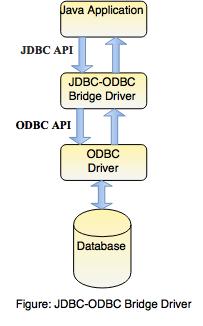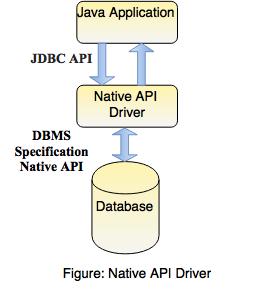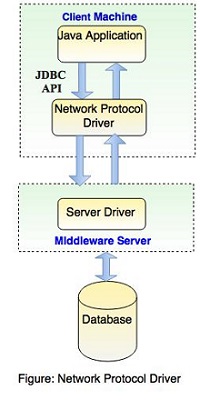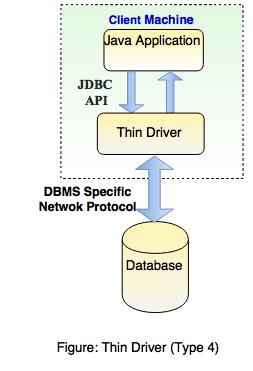JDBC Driver
A JDBC driver is set of software components that help a Java application to interact with database. The JDBC driver implements lots of JDBC classes and interfaces that enable to open connection and interact with database server.
There are 4 types of JDBC drivers:
Type 1 : JDBC-ODBC bridge driver
Type 2 : Native API driver (Partial Java driver)
Type 3 : Network Protocol driver (Pure Java driver for database middleware)
Type 4 : Thin driver (Pure Java driver)
Type 1 : JDBC-ODBC Bridge Driver
- The JDBC-ODBC is also known as Type 1 driver.
- The JDBC-ODBC bridge driver converts the JDBC method call into the ODBC function call.
- The ODBC depends on native libraries of the operating system.
- This driver is platform dependent.
- Sun provides the JDBC-ODBC Bridge driver by following URL - “sun.jdbc.odbc.JdbcOdbcDriver”
Advantages- It can connect to any database on which ODCB driver is installed.
- Easy to install and use.
Disadvantages- Performance overhead
- Installed on each client machine
- Not suitable for applet programming.
Architecture of Type 1 Driver

Type 2 : Native API Driver (Partial Java driver)
- The Native API driver is also known as Type 2 driver.
- Type 2 driver uses the native code part instead of ODBC parts. It uses the client-side libraries of the database.
- It is vender specific driver, so must be installed on each client system. This driver converts the JDBC method call into native call of database.
- The Oracle Call Interface (OCI) driver is an example of a Native API Driver.
Advantages- It is faster than type 1 driver.
Disadvantages- Type 2 driver is platform dependent.
- It uses the vendor class libraries, so needs extra installation on client machine.
- It does not support applet programming.
Architecture of Type 2 Driver

Type 3 : Network Protocol Driver
- It is also known as Type 3 or Pure Java driver for database middleware.
- The Network protocol driver uses the three-tier model.
- The middle tier is responsible to converts JDBC calls directly or indirectly into vender specific database protocol.
- This type of driver is very flexible that is a single driver can actually provide access to multiple databases.
Advantages- No need of database vendor library on the client.
- A single driver can handle any database, provided by the middle tier.
- It can be used in any web application and no need to install any software on client machine.
Disadvantages- It increases the complexity because at middleware we develop the database coding.
- The client machine must support network protocol.
Architecture of Type 3 Driver

Type 4 : Thin driver (Pure Java driver)
- It is a pure Java driver which connects all Java drivers directly to the vendor specific database protocol.
- This driver provides the highest performance driver for the database. Thin driver is completely written in Java because of that it is known as 100% pure Java driver.
Advantages- It is platform independent means pure Java driver.
- Performance is very good in comparison to all other drivers.
- No need of any middleware services.
- All the processes of application are managed by JVM.
Disadvantages- Need a separate driver for each database.
Architecture of Type 4 Driver




